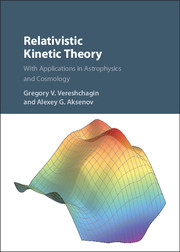Book contents
- Frontmatter
- Contents
- Preface
- Acknowledgments
- Acronyms and Definitions
- Introduction
- Part I Theoretical Foundations
- Part II Numerical Methods
- 7 The Basics of Computational Physics
- 8 Direct Integration of Boltzmann Equations
- 9 Multidimensional Hydrodynamics
- Part III Applications
- Appendix A Hydrodynamic Equations in Orthogonal Curvilinear Coordinates
- Appendix B Collision Integrals in Electron-Positron Plasma
- Appendix C Collision Integrals for Weak Interactions
- Bibliography
- Index
9 - Multidimensional Hydrodynamics
from Part II - Numerical Methods
Published online by Cambridge University Press: 09 March 2017
- Frontmatter
- Contents
- Preface
- Acknowledgments
- Acronyms and Definitions
- Introduction
- Part I Theoretical Foundations
- Part II Numerical Methods
- 7 The Basics of Computational Physics
- 8 Direct Integration of Boltzmann Equations
- 9 Multidimensional Hydrodynamics
- Part III Applications
- Appendix A Hydrodynamic Equations in Orthogonal Curvilinear Coordinates
- Appendix B Collision Integrals in Electron-Positron Plasma
- Appendix C Collision Integrals for Weak Interactions
- Bibliography
- Index
Summary
This chapter describes multidimensional hydrodynamics, and it contains four sections. The first section discusses classical multidimensional shock-capturing hydrodynamics and the application of modern high-order Godunov-type methods that reduce the problem into a class of almost engineering tasks.
Scientific input includes equations of state, reaction rates, and kinetic coefficients, described in the second section. The main difficulties of the kinetic Boltzmann approach discussed in the previous chapter are not only the multidimensionality of the phase space but also the calculation of the reaction rates. These reaction rates usually require using implicit schemes in the case of nontransparent regions, and multidimensional problems become very hard to study. The key point of this section is the proposal to move from the kinetic Boltzmann treatment in 7D phase space (r,p, t) to a hydrodynamic one with diffusion and flux limiters in 5D phase space (r, ϵ, t). The diffusion with flux limiter approach uses some free parameters for the interpolation of spectral energy fluxes in the intermediate case between the transparent (free flow) and the nontransparent (diffusion or heat conduction) regions. The first calculations within such an approach were performed in [131] for the gravitational collapse with the neutrino transport in spherically symmetric case. In such a problem one has to carry out advection by explicit code. At the same time, diffusion of spectral energies is carried out by an implicit scheme, such as the Crank-Nicolson method [100]. Finally, reaction rates are computed using an implicit scheme for the system of ODEs. In the multidimensional 2D or 3D cases the splitting on the time integration along separate directions is made. Given the limited space resolution in the 3D case in comparison with the 1D one, high-order Godunov-type methods are required.
The third section discusses the Riemann problem solver within special relativity. The numerical relativity does not offer universal receipts. Moreover, the current state of numerical relativity in strong gravitational fields is more similar to art than to science. Therefore, in this section, only special relativistic high-order shock-capturing methods are discussed.
The fourth section briefly describes particle-based simulations, in particular, the smoothed-particle hydrodynamics method. Such mesh-free methods are an attractive alternative to traditional grid-based hydrodynamics.
- Type
- Chapter
- Information
- Relativistic Kinetic TheoryWith Applications in Astrophysics and Cosmology, pp. 106 - 132Publisher: Cambridge University PressPrint publication year: 2017



